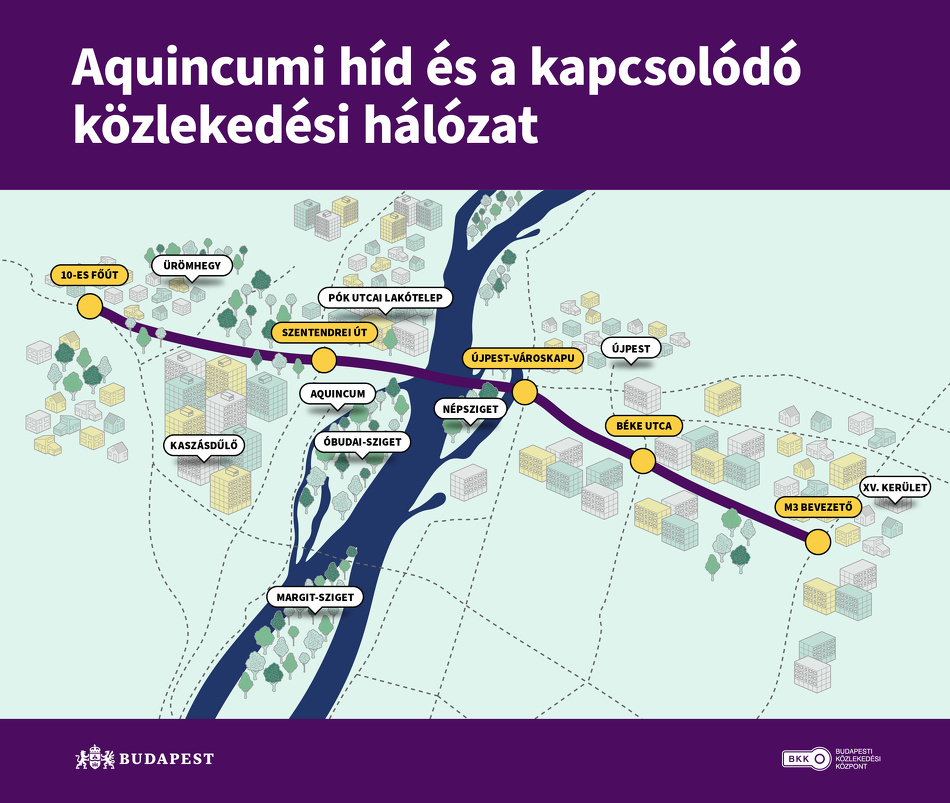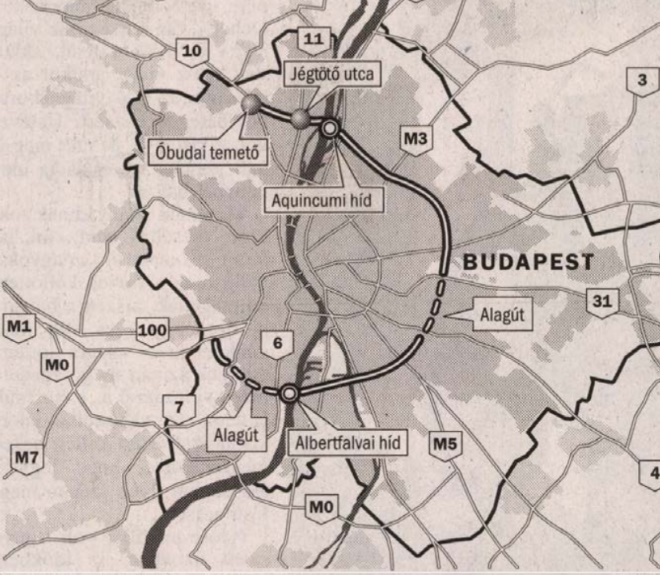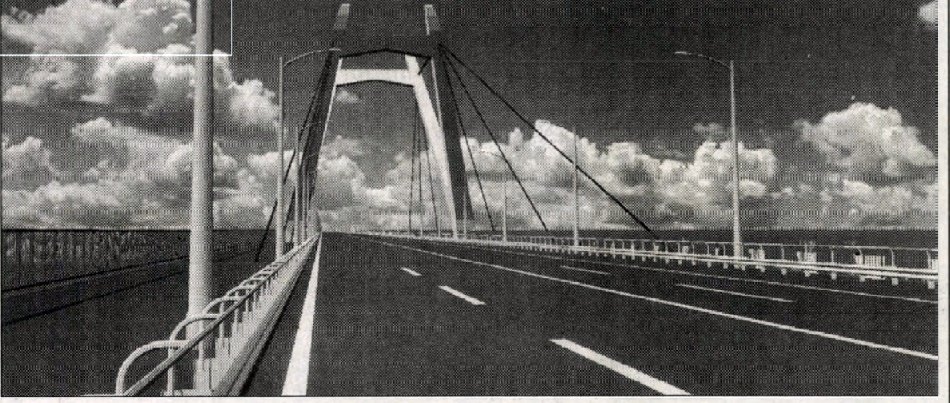In the construction of the Danube bridges in Budapest, a tradition can be observed that a bridge is built in the north, then in the south, then again in the north, and so on. Following this logic, the next Danube crossing in Budapest will be the bridge planned for the line of Galvani Road, after which another Danube bridge can be built in the north, between Óbuda and Újpest. The Aquincum Bridge has been included in the plans of Budapest for a very long time, as it was already included in the Bridge Program adopted in 1986 as a crossing to be built in the long run.
Five alternatives are being considered for the role of this long-planned Danube bridge in Budapest's transport. For the time being, the question is not what the type of bridge should be, ie whether an arch bridge, a girder bridge or a suspension bridge should be built, but how big area it should serve.

Location of the planned bridge and possible road connections (bkk.hu)
What does this mean? The Megyeri Bridge or the Deák Ferenc Bridge is a motorway bridge, an integral part of the national transport network. The traffic of the Elizabeth Bridge does not only serve the people of Budapest. While, say, the Chain Bridge or the Liberty Bridge is used more by local commuters. The Aquincum Bridge could be any of these, though the capital has ruled out being a kind of urban highway bridge, but nonetheless, there is a relatively wide range of options for how much traffic it can handle.
The Budapest Transport Center (BKK) is preparing a detailed feasibility study on behalf of the Budapest Local Government, and Budapest residents can also give their opinion on the BKK website. There are five options listed. In the first four cases, the bridge itself would be the same, with 2x2 lanes. The difference is in how they drive traffic to it. The idea so far - which is now version “A” - would be to travel on a relatively high-capacity 2x2-lane road between road 10 and the M3, with 34,600 vehicles a day.

A very old, more than 20-year-old idea of the route of the outer ring road (Source: Népszabadság, 4 November 2000)
In the other options, the associated road network would change, in option “B” the roads to the M3 and road 10 outside the bridge would be narrower. In the third version, this would change so much that one of the lanes on the bridge would be a bus lane. In the fourth idea, the road connection would be even more limited, because then the road on the Buda side would only lead to Szentendrei Road, ie it would not reach road 10, and there would be a bus lane on the bridge here as well.
These ideas therefore differ in how deeply the road networks connected to the bridge “extend” into the transport fabric of the city. It can be seen that if these connected roads penetrate deeply and widely into the network of roads in Óbuda and Újpest, they will generate more intensive traffic. Of course, traffic would be reduced elsewhere, and it is also important that a well-designed network is also a step forward in reducing travel time, which is a saving in many ways.
The fifth version is the most surprising, because it would act as a purely public transport bridge, connected to the existing road network, ie cars could not travel on the bridge, which is interesting because the location of the bridge is fixed: it would pass next to the Újpest railway bridge. On the railway bridge, on the other hand, pedestrian and bicycle transport is still possible today, ie it would only provide additional opportunities for buses and taxis, and pedestrian and bicycle transport would be transferred here.
We don't know much about the Aquincumi bridge from the current prospectus, one thing is for sure that it should be somewhat aligned with the existing railway bridge, so the task here would be the same as in the case of the Rákóczi bridge, ie the bridge fitting to the railway bridge should be designed.
As we have written, the need for a road connection has been discussed here for a very long time. In the aforementioned 1986 Bridge Program, experts looked to the long term and proposed a 2x2-lane bridge that would be connected to a new ring road, a circle railway ring road. Moreover, it came up already in the 1860s that there should be a connection between Újpest and Békásmegyer.

Side and top view of the crossing outlined in the 1986, almost 40-year-old Bridge Program together with the railway bridge (Source: A fővárosi közúti dunai átkelő kapacitások fejlesztése, Hídprogram [Development of the Danube Crossing Capacities in the Capital, Bridge Program] July 1986)
The construction of the bridge was still on the agenda at the end of the 1990s, and even then it was discussed as the first element of the new ring road between Hungária Boulevard and M0. At that time, the bridge was in “competition” with the Megyeri Bridge, but since the management of Újpest did not want to see the entire traffic crossing the Danube in northern Budapest, it did not support its construction, so in 1999 they finally decided on the Megyeri Bridge.
A few years later, the bridge builders investigated whether the old 1990 structure of the Deák Ferenc Bridge, which was not being renovated but would be rebuilt, could be re-used here, ie the old structure could be floated on the river and rebuild here. However, this was discarded and a decision was made to renew the old structure of the Deák Ferenc Bridge.
Whatever crossing will eventually take place between Óbuda and Újpest, its construction is not expected in the near future, as the following note is available on the BKK website for each version:
" The construction of the bridge and the associated road network would only take place after the construction of the section of the M0 motorway between roads 10 and 11."
This is understandable somewhere, as no matter how limited the road network is, if there is no M0 between road 10 and road 11, traffic on road 10, mainly to the M3, would pass here. A design procurement for this phase was announced in February this year, but given that two tunnels will need to be drilled here, the road is not expected to be handed over in the near future.
Cover photo: Visual plan of Főmterv about the bridge around the turn of the millennium (Source: Népszabadság, 29 February 2000)




































Hozzászólások
Log in or register to comment!
Login Registration